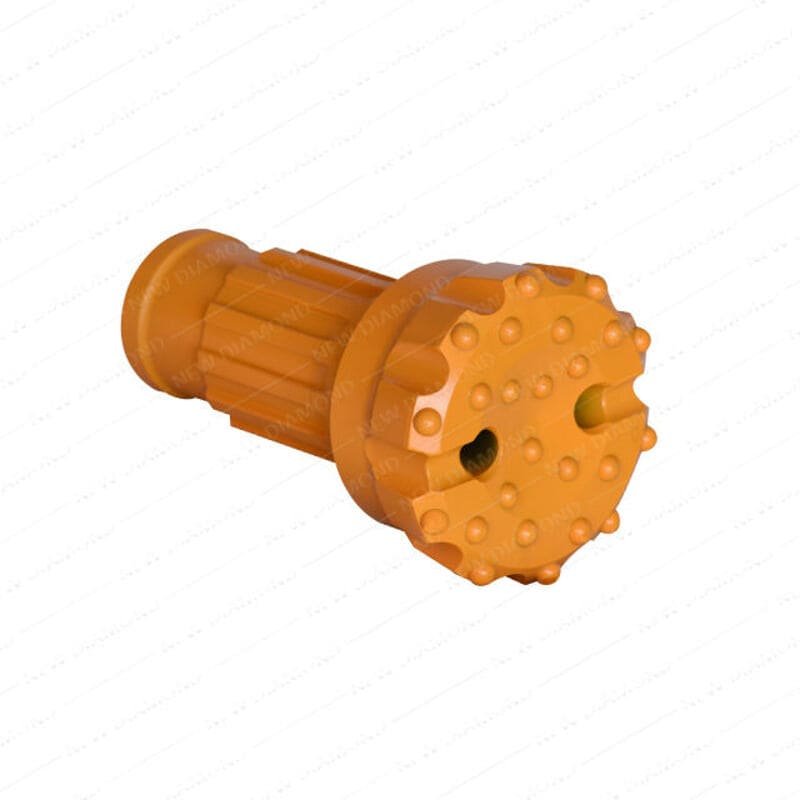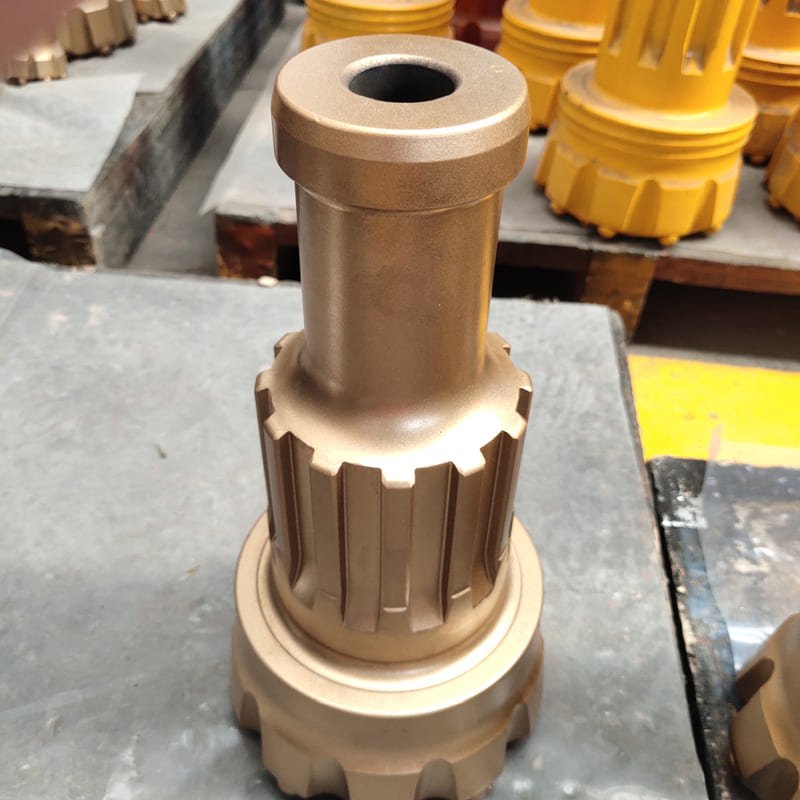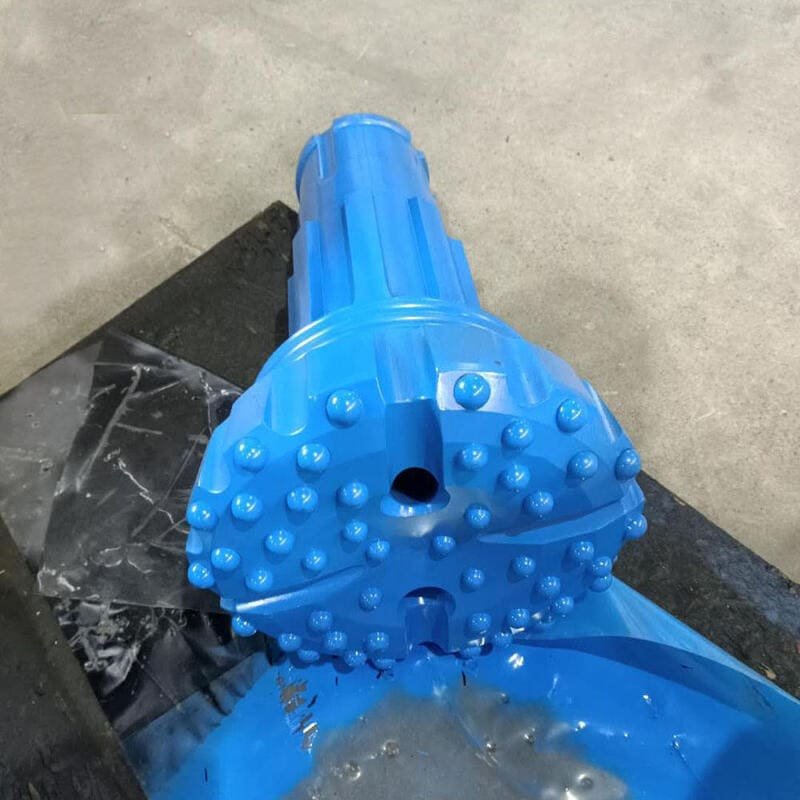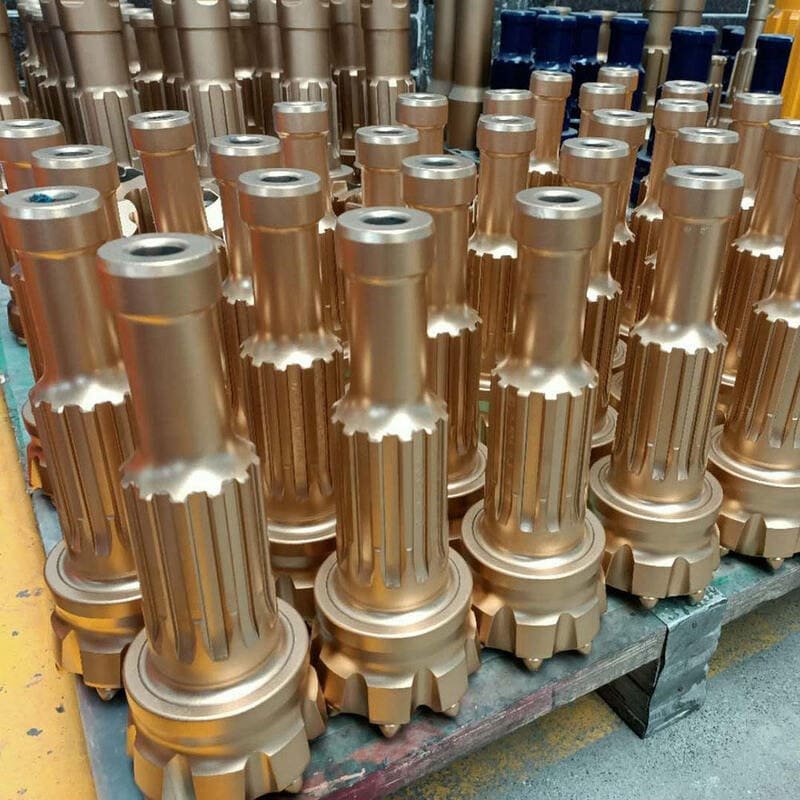Ever wondered why your DTH drill bits are cracking too soon? It’s all about the heat!
Heat checking on DTH drill bits happens due to thermal fatigue, triggered by rapid temperature changes during drilling. This leads to tiny cracks on the bit surface, particularly around carbide buttons, which can cause premature failure if not properly managed.
Picture this: you're in the middle of a crucial drilling operation, everything's going smoothly, and suddenly, the drill bit fails. It turns out those tiny cracks weren’t so tiny after all. Understanding what causes these cracks—essentially, the drastic heating and cooling cycle—is key to extending the life of your drill bits. By addressing these temperature-related issues, we can prevent early failures and keep our projects on track. It's all about balancing the heat to maintain efficiency and longevity in our drilling equipment.
Rapid temperature changes cause heat checking on drill bits.True
Thermal fatigue from rapid temperature changes leads to heat checking.
Heat checking only affects the bit's surface appearance.False
Heat checking causes cracks that can lead to premature failure.
How Do High Temperature Fluctuations Affect Drill Bits?
Ever wondered how a drill bit can survive the fiery heat of drilling? I have too, especially when those temperature swings threaten to wear them out before their time.
High temperature fluctuations can stress drill bits, causing heat checking and early wear. By choosing the right materials and ensuring proper cooling, I’ve found it possible to keep drill bit performance up to snuff.

The Impact of Thermal Stress
When I'm knee-deep in a drilling project, I know how critical it is to keep an eye on the heat my drill bits endure. Every time they cut through tough materials, the friction generates a lot of heat. Imagine being in a sauna one minute and then plunged into an icy pool the next—it's not so different for these tools. The constant expansion and contraction can lead to what's known as heat checking—tiny cracks that slowly undermine the bit's strength.
Material Considerations
Over time, I've learned that not all drill bits are created equal. For instance, tungsten carbide might sound like a robust choice, but the devil's in the details—especially when it comes to thermal expansion. Selecting materials that stand up well under intense heat can make all the difference. It’s like picking the right boots for hiking; you want them durable and reliable, no matter what path you’re on.
| Material Type | Thermal Resistance | Wear Resistance |
|---|---|---|
| Standard Carbide | Moderate | High |
| Enhanced Carbide | High | Very High |
Role of Cooling Systems
Cooling systems have saved me more times than I can count. They’re like that trusty friend who always knows when to pass you a cold drink on a hot day. Whether it’s using water or air to flush away the heat, getting it right is key. I’ve noticed that when cooling is off, even slightly, it can lead to more stress on the bit.
Adequate cooling is essential to counteract the heat generated during drilling. Flushing fluids like water or air are commonly used to maintain optimal bit temperature. Effective cooling minimizes thermal stress, thereby reducing wear and tear risk.
Operational Parameters
Drilling speed and pressure are my secret sauce for keeping things under control. Pushing too hard can mean more heat and stress—like trying to rush through a long run. By carefully adjusting these settings based on what I’m drilling through, I manage to keep my bits running smoother and longer.
Adjusting operational parameters such as drilling speed and pressure can enhance drilling efficiency1 and extend drill bit life.
Environmental Influences
Drilling in hot climates or against stubborn rock types can be tricky. The ambient temperature can raise the stakes by starting everything off warmer than usual. Plus, some rocks just seem to love making things harder by generating more friction. Understanding these factors ahead of time helps me prepare and tweak my approach as needed.
Training myself and my team to spot overheating signs early means we can adjust before things get out of hand. It’s all about anticipating problems and tackling them head-on. By staying informed and adaptable, I’ve managed to extend the life of my drill bits and keep operations flowing smoothly.
Explore more2 about selecting appropriate materials and operational parameters for different geological scenarios.
High speeds reduce heat in drill bits.False
High speeds increase friction, generating more heat, not less.
Enhanced carbide resists thermal stress better.True
Enhanced carbide has high thermal resistance, reducing stress effects.
How Does Inadequate Cooling Affect Heat Checking?
Ever been knee-deep in a drilling project and wondered why your drill bits just can't seem to last?
Inadequate cooling during drilling causes heat checking by creating uneven temperature distribution and excessive thermal stress on drill bits. This results in surface cracks, diminishing the bit's performance and longevity.

Understanding Heat Checking
I remember my first big drilling project vividly. There I was, optimistic, with a fresh set of drill bits ready to tackle the task at hand. But soon, I noticed those pesky surface cracks starting to appear—heat checking, they called it. It seemed like my drill bits were just crumbling under the stress, almost like they had a mind of their own, succumbing to the relentless heat.
The Impact of Inadequate Cooling
Just like how I felt when running a marathon without proper hydration, my drill bits were suffering from inadequate cooling. When cooling isn't up to par, the temperature difference between the surface and interior of the bit grows. This uneven temperature distribution3 causes the material to expand and contract unevenly, leading to those stubborn cracks. Imagine your favorite mug shattering because you poured hot coffee right after taking it out of the freezer—that's what happens to my drill bits.
Factors Contributing to Insufficient Cooling
| Factor | Description |
|---|---|
| Fluid Flow | Insufficient fluid flow fails to dissipate heat effectively. |
| Fluid Type | Using inappropriate fluids can reduce cooling efficiency. |
| Equipment Settings | Incorrect pressure or flow settings exacerbate heat build-up. |
Importance of Proper Cooling Systems
I quickly learned that having a proper cooling system is like bringing your own shade to a desert trek—it makes all the difference. Ensuring adequate fluid flow and selecting the right type of cooling fluid can mitigate heat checking. Adjusting equipment settings4 to optimize cooling performance is equally important.
Practical Solutions
After several trials and errors—and a few too many cracked bits—I realized how crucial regular inspection and adjustment of cooling systems are. Checking fluid levels, cleaning nozzles, and calibrating pressure settings became my go-to rituals. Using sensors to monitor temperature changes in real-time helped me catch potential issues before they could wreak havoc.
Key Actions:
- Regular maintenance of cooling systems.
- Use of high-quality, appropriate cooling fluids.
- Real-time monitoring with temperature sensors.
- Training operators in recognizing and mitigating overheating signs.
By addressing inadequate cooling, I've managed not only to extend the life of my drill bits but also to improve overall operational efficiency. For anyone involved in drilling operations, from procurement directors like Gary5 to on-site engineers, understanding these factors is essential.
Inadequate cooling increases heat checking risk.True
Insufficient cooling causes uneven temperature distribution, leading to cracks.
Proper fluid flow prevents drill bit heat checking.True
Adequate fluid flow dissipates heat effectively, reducing thermal stress.
How do material properties influence heat checking?
Ever wondered why some materials crack under heat while others seem invincible?
Material properties like thermal conductivity, expansion coefficients, and wear resistance play a big role in heat checking. Materials with high thermal conductivity, like copper, dissipate heat efficiently, reducing stress and cracking. Meanwhile, low expansion coefficients in materials prevent crack formation by minimizing material distortion.

When I first started working in the drilling equipment industry, understanding how different materials react under intense heat was crucial. I remember my first big project, where heat checking became a major headache. The cracks that formed on the surface of our drill bits were puzzling at first, but it turned out to be a fascinating journey into the world of thermal properties.
Understanding Thermal Conductivity's Role
I learned that thermal conductivity is like the unsung hero in managing heat distribution across a material's surface. Imagine working with copper or aluminum, which are materials that efficiently disperse heat—it's like having a cooling system built right into your tools. During those early projects, I realized that high thermal conductivity can actually save you from the nightmare of thermal fatigue6, which is one of the main culprits behind heat checking.
| Material | Thermal Conductivity (W/m·K) |
|---|---|
| Copper | 401 |
| Aluminum | 237 |
| Steel | 50 |
| Tungsten | 173 |
Thermal Expansion Coefficients
One particular project still stands out in my memory. The bits expanded more than expected when heated, causing stress and eventually cracking. That's when I understood the importance of thermal expansion coefficients. Materials like ceramics that have low expansion rates hold their shape better under temperature swings, making them perfect for challenging high-temperature applications.
Wear Resistance and Material Integrity
Wear resistance was another lesson learned on the job. Watching tungsten carbide maintain its structural integrity over countless heating and cooling cycles was like witnessing magic. These materials resisted degradation so well that they reduced the chances of heat checking, simply by staying robust and uniform.
Influence of Material Composition
In one of our brainstorming sessions, we discussed adding chromium to steel to boost its resistance against oxidation and heat. It was exciting to see how slight tweaks in composition could significantly enhance performance in thermal environments7. It's these subtle changes that optimize materials for specific applications.
In summary, choosing the right materials with balanced thermal properties has been key in my projects to prevent heat checking. Whether it's tweaking compositions or selecting materials based on their thermal conductivity and expansion properties, understanding these factors has been invaluable in engineering durable components for high-temperature use.
Copper reduces thermal stress due to high conductivity.True
Copper's high thermal conductivity (401 W/m·K) disperses heat efficiently.
Steel has higher thermal conductivity than aluminum.False
Steel's conductivity is 50 W/m·K, lower than aluminum's 237 W/m·K.
How Do Operational Parameters Influence Heat Checking?
Remember that time when your drill bits just couldn’t take the heat? It’s not just frustrating—it’s costly.
Operational parameters like drilling speed, pressure, and cooling efficiency significantly affect heat checking in drill bits. By optimizing these factors, you can minimize thermal stress and extend the life of your equipment.

I vividly recall my first encounter with heat checking in DTH drill bits. It was one of those days where everything that could go wrong did. Picture this: we were in the middle of a critical drilling project, and suddenly, I noticed tiny cracks forming on the drill bit surfaces. It was a real head-scratcher at first, but as it turned out, the culprit was the operational parameters we’d been using all along.
Understanding Heat Checking
Heat checking refers to the pesky small, shallow cracks on the surface of drill bits due to thermal fatigue. These micro-cracks can really put a damper on things if not managed properly, especially affecting DTH (Down-The-Hole) drill bits during operations.
High Temperature Fluctuations
Here’s the thing: operational parameters can really throw temperature fluctuations out of whack. Back then, I realized our drilling speeds were too high, which ramped up friction and heat at the cutting surfaces more than we’d anticipated. The carbide buttons bore the brunt of this heat, undergoing intense thermal cycling.
- Impact of Speed: Faster drilling speeds meant our bits went through rapid heating and cooling cycles faster than a rollercoaster ride.
- Role of Pressure: We were applying too much pressure, unknowingly adding to mechanical stresses and encouraging crack formation.
| Parameter | Effect on Heat Checking |
|---|---|
| Drilling Speed | Increases thermal cycling |
| Drilling Pressure | Elevates mechanical stress |
Cooling and Flushing Efficiency
To say our cooling was inadequate would be an understatement. We had to learn the hard way that managing flushing fluids efficiently is crucial.
- Fluid Flow: We weren’t using enough fluid flow to cool efficiently, which allowed heat to build up excessively.
- Fluid Type: Eventually, we found out that choosing the right type of fluid could make a world of difference in cooling effectiveness.
Explore fluid management techniques8
Material Properties Influence
Material selection also plays a pivotal role. Once we switched to high-quality carbide materials, they resisted thermal stress much better, helping us reduce those nasty heat checks.
- Thermal Resistance: Good materials can handle thermal stress better.
- Wear Resistance: As bits wear down, their heat dissipation capacity drops like a rock.
Learn more about material selection9
Environmental Factors
Don’t overlook environmental factors either. Ambient temperature and rock type can greatly influence how operational parameters affect heat checking.
- Ambient Conditions: High environmental temperatures can push operational temperatures even higher.
- Rock Hardness: Harder rocks? They bring more frictional heat to the party.
Mitigation Strategies
To keep those heat checks at bay, tweaking operational parameters is a must.
- Adjust drilling speeds and pressures to manage frictional heat.
- Use effective cooling systems to maintain efficient flushing and cooling cycles.
- Opt for materials with high thermal resistance for better longevity.
Discover more mitigation strategies10
High drilling speeds increase heat checking risk.True
Faster speeds cause rapid heating cycles, intensifying thermal fatigue.
Drilling pressure has no effect on heat checking.False
Excessive pressure increases mechanical stress, leading to crack formation.
Do Environmental Conditions Contribute to Heat Checking?
Ever wondered why your drill bits seem to give up quicker in certain conditions? Environmental factors might be the culprit!
Yes, environmental conditions like high temperatures and specific rock types can worsen heat checking in drilling equipment due to increased thermal stress and friction.

High Ambient Temperatures
I remember the first time I faced serious drilling issues because of environmental conditions. It was a hot summer day, and I noticed the drill bits were wearing out faster than usual. That's when I realized just how much ambient temperature can play a role.
The heat was relentless that day, and I felt it not just on my skin but also in the way my equipment was reacting. High ambient temperatures elevate the baseline temperature of the drilling equipment, making it more susceptible to thermal fatigue. This constant exposure can quickly wear down drill bits, especially around those hard-working carbide buttons. I learned the hard way that monitoring ambient conditions is crucial, so now I always keep an eye on the thermometer and adjust the cooling systems11 accordingly.
Influence of Rock Type
Then there was the time we were drilling through granite. The bit seemed to be screaming for mercy with all the friction it was enduring. Hard, abrasive rocks like granite or quartzite generate a lot of heat due to their resistance, which increases the risk of thermal cycling and potential heat checking. Now, before tackling any geological challenge, I make sure to understand the rock type and adjust my drilling parameters12 accordingly.
Drilling Operations and Thermal Management
I've learned through experience that how you operate your drill affects heat generation too. High-speed operations can produce more heat due to friction, while increased pressure intensifies mechanical stress. By adjusting these parameters and implementing efficient thermal management strategies, I've managed to reduce incidents of heat checking significantly.
| Parameter | Impact |
|---|---|
| High Speed | Increased friction and heat generation |
| High Pressure | Greater mechanical stress |
Having a reliable flushing system13 is a game-changer, ensuring the bits are cooled efficiently by managing fluid type and flow rate based on current conditions.
Material Considerations
Selecting the right materials is another lesson learned from experience. Drilling equipment with high thermal resistance, such as tungsten carbide, tends to fare better under extreme conditions. However, differences in thermal expansion coefficients between materials used in drill bits can cause problems if not addressed properly. Regular inspections for heat damage and timely replacement of components have become part of my routine maintenance to ensure optimal performance.
With a deeper understanding of material science14, I've optimized how I select and maintain my equipment to withstand varying environmental challenges.
High ambient temperatures increase heat checking risk.True
Elevated temperatures raise equipment's baseline temperature, enhancing thermal fatigue.
Soft rocks generate more heat than hard rocks during drilling.False
Hard or abrasive rocks generate more friction and heat at contact points.
What strategies can I use to mitigate heat checking on drill bits?
Have you ever watched a drill bit struggle under the heat of friction and thought, 'There must be a better way'?
To mitigate heat checking on drill bits, I focus on optimizing drilling parameters, enhancing cooling systems, selecting thermally stable materials, conducting regular maintenance, and training operators. These steps help me reduce thermal stress and improve bit longevity.

Optimize Drilling Parameters
I remember the first time I realized the importance of adjusting drilling parameters—it was like a light bulb moment. By tweaking the rotational speed, hammer pressure, and feed rate, I found that I could significantly cut down on the frictional heat generated. It’s all about finding that sweet spot where the bit stays cool and efficient. This careful adjustment minimizes excessive heat generation15 during drilling operations.
Enhance Cooling and Flushing
Think of this step like giving your drill a refreshing drink on a hot day. Ensuring effective cooling and flushing systems is crucial. I’ve learned that using adequate fluid flow and pressure, tailored to specific environments, makes all the difference.
| Fluid Type | Cooling Efficiency | Use Case |
|---|---|---|
| Air | Moderate | Dry, less abrasive environments |
| Water | High | Wet, abrasive environments |
Whether it's air for dry conditions or water in wet, abrasive environments, the right choice can keep things cool based on environmental and drilling conditions16.
Select Appropriate Materials
Choosing the right materials for drill bits feels a bit like picking a solid pair of hiking boots. I opt for high-quality, thermally stable materials for carbide buttons and bit bodies. This ensures the bit can withstand thermal stresses better, reducing those pesky heat checks.
Regular Maintenance and Inspection
I can’t stress enough how regular maintenance saves me headaches down the line. By routinely checking for signs of wear and heat checking, I ensure even wear and heat distribution. Consistent practices prevent premature tool failure by preventing premature failure17 of the tools.
Train Operators
Training operators is like having a team of skilled chefs in your kitchen—they need to know their craft to prevent overheating issues. Educating them on recognizing signs of overheating and adjusting operational parameters is key. This proactive approach greatly reduces heat checking incidents.
Implementing these strategies means combining technology with human expertise. By addressing both aspects, I can effectively minimize heat checking on drill bits, enhancing their lifespan and efficiency.
Adjusting drilling parameters reduces heat checking.True
Optimizing speed and pressure minimizes frictional heat, reducing thermal stress.
Water is less effective than air for cooling drill bits.False
Water has a higher cooling efficiency than air, especially in abrasive environments.
Conclusion
Heat checking in DTH drill bits occurs due to thermal fatigue from rapid temperature changes, leading to cracks that can cause premature failure if not managed properly.
-
Discover the optimal settings for drilling speed and pressure to minimize heat generation and extend drill bit lifespan. ↩
-
Explore materials known for high thermal resistance that can enhance the durability and efficiency of drill bits. ↩
-
Understanding temperature distribution's effect on material stress is key to preventing thermal fatigue and ensuring drill bit longevity. ↩
-
Discovering optimal equipment settings can enhance cooling efficiency, reducing the risk of heat checking. ↩
-
Procurement directors like Gary play a vital role in equipment selection and maintenance strategies. ↩
-
Learn about thermal fatigue to understand how heat affects material longevity and performance. ↩
-
Discover how different materials perform in thermal environments to choose the right one for your application. ↩
-
This link offers insights into managing fluids effectively to prevent overheating during drilling. ↩
-
Learn about materials that enhance the thermal durability of drill bits to reduce cracking. ↩
-
Explore methods to optimize operational parameters and prevent heat checking. ↩
-
Explore how effective cooling systems can reduce wear and extend the lifespan of drill bits in high-temperature environments. ↩
-
Discover how adjusting drilling parameters for specific rock types can prevent excessive heat generation. ↩
-
Learn why flushing systems are crucial for maintaining optimal temperatures during drilling operations. ↩
-
Understand how different materials withstand thermal stress to improve drill bit design. ↩
-
Learn how proper adjustment of drilling parameters can significantly lower frictional heat during operations. ↩
-
Explore which cooling fluids are most effective in different drilling environments to reduce heat checking. ↩
-
Discover maintenance practices that prevent premature failure and extend the lifespan of drill bits. ↩








